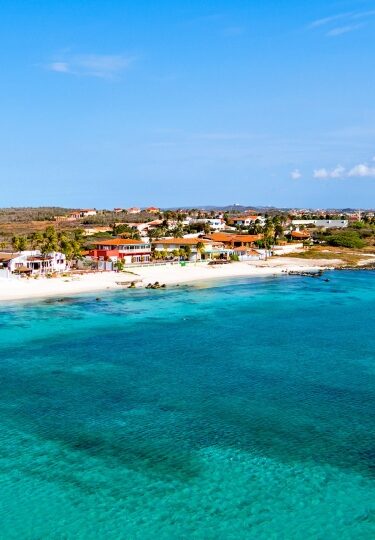Author’s Note: Having been brought up in Greece, I could float and snorkel from before I could even swim properly and I’ve loved the experience of floating along with the meditative sound of my own breath and the occasional bubble ever since. The Caribbean has been one of my favourite spots to snorkel since I first visited more than 20 years ago, and I love Aruba’s wide variety of snorkel spots around the island.
The small southern Caribbean island of Aruba is home to many of the Caribbean’s well-known draws including warm turquoise water, white sand beaches, colorful downtown blocks in the capital of Oranjestad, and vibrant coral reefs near the shore.
Snorkeling in Aruba is a popular pastime because of the island’s clear and calm waters, which offer ideal conditions for snorkeling—you can often see as far as 100 feet, and waves and currents are quite minimal.
Aruba also has shallow beach drop-offs, making most of the water around the beaches pretty warm; the average is around 80 to 85 degrees Fahrenheit. In other words, the island seems as if it was intentionally designed as a snorkeler’s paradise.
If you’re heading there on a vacation and are not sure where to begin, read on and discover the best spots for snorkeling in Aruba.
De Palm Island
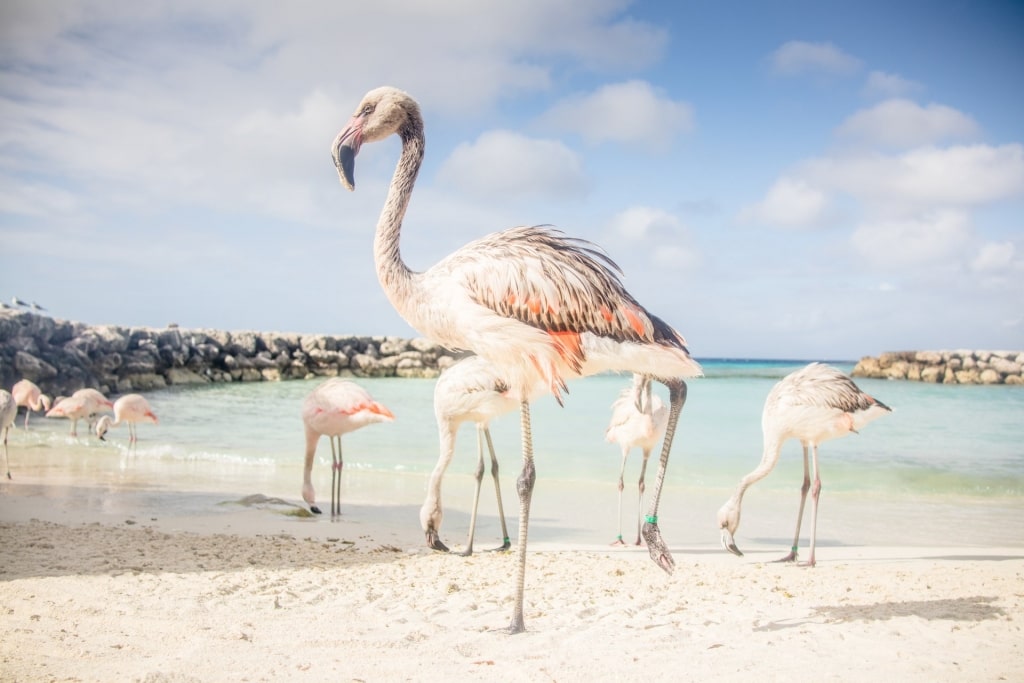
De Palm Island
One of the best things to do in Aruba is to head to De Palm Island off the coast of the mainland for snorkeling and other watersports. De Palm has its own coral reef surrounding the island, where you can snorkel from the shore rather than having to take a boat tour. De Palm Island is a great place for beginner snorkelers as it offers complimentary snorkel tours twice a day, where you’re likely to see some of the island’s colorful fish in water no more than waist-deep.
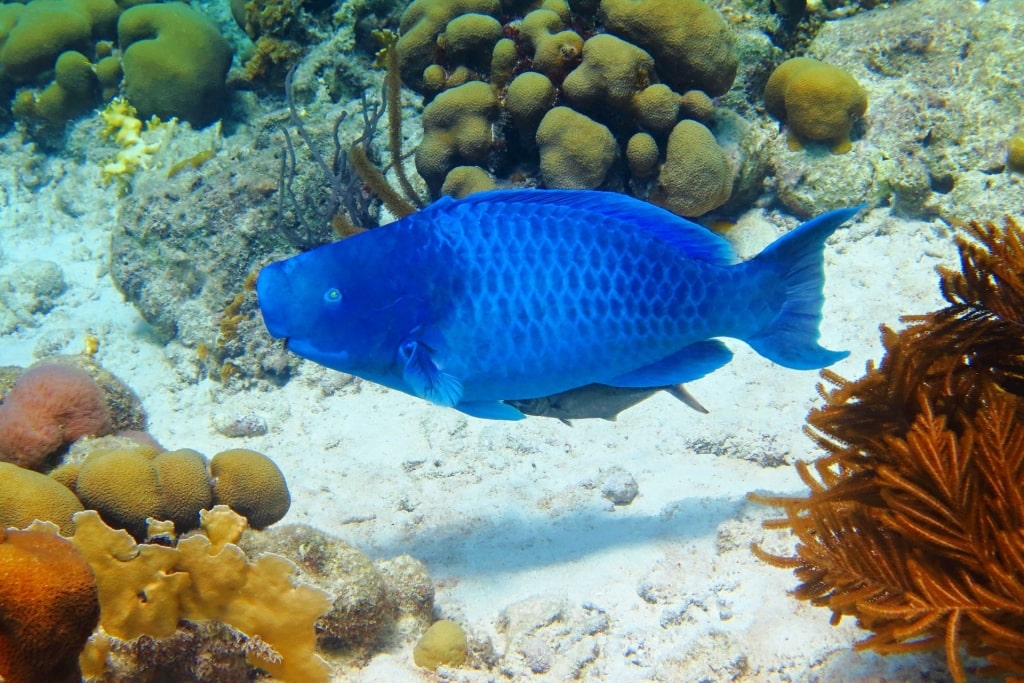
De Palm Island
On the reefs, look for parrotfish and triggerfish in various hues; yellow or black-and-white striped angelfish; and, if you keep your eyes on the nooks in the reef, you may even see spotted moray eels. If you don’t want to go on a tour, you can always rent snorkel equipment on the island and go on your own excursion offshore.
Since De Palm is a private island, it operates on an all-inclusive basis. Once you’ve had your fill of snorkeling (or while you’re taking a break in the shade), it’s easy to grab an icy cocktail and authentic Aruban food or relax on a lounger in the surf.
For those traveling with families, some of the best things to do in Aruba with kids include banana boat rides and snuba excursions.
These are a perfect option if you’re ready to move beyond snorkeling but aren’t quite prepared to try scuba diving yet.
The Antilla Shipwreck
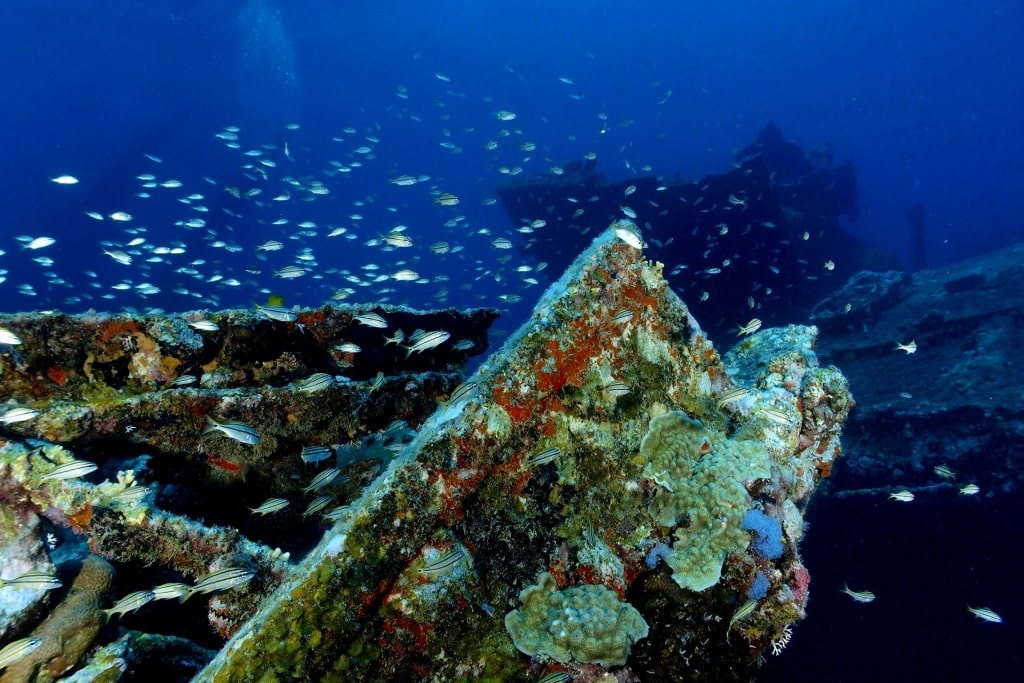
The Antilla Shipwreck
Most shipwrecks are reserved for scuba divers that can reach deeper ocean depths. But luckily, the 1940 sinking of the Antilla shipwreck is one of the best and most easily accessed snorkeling sites in Aruba.
Measuring over 400 feet long, this surprisingly intact shipwreck is the second-largest one in all of the Caribbean. A former German trade ship in the 1930s, the Antilla sank during the era of Nazi rule and while there are several theories as to why it ended up in the bottom of the ocean, there is still no proven explanation for its sinking.
You could easily spend hours swimming around this large shipwreck. The deepest part of the Antilla sits in 60 feet of water, while the shallowest end is around 25 feet deep. Since visibility is possible between 70 and 90 feet, it’s easy to see the entire ship from above, even if you don’t dive down to the bottom of the ocean.
During your visit to Antilla, you’re likely to see any number of animals found in Aruba’s waters, but the wreck is most known for its healthy and colorful coral formations, which attract lobsters, eels, sea turtles, and large schools of fish in the shadows.
Boca Catalina
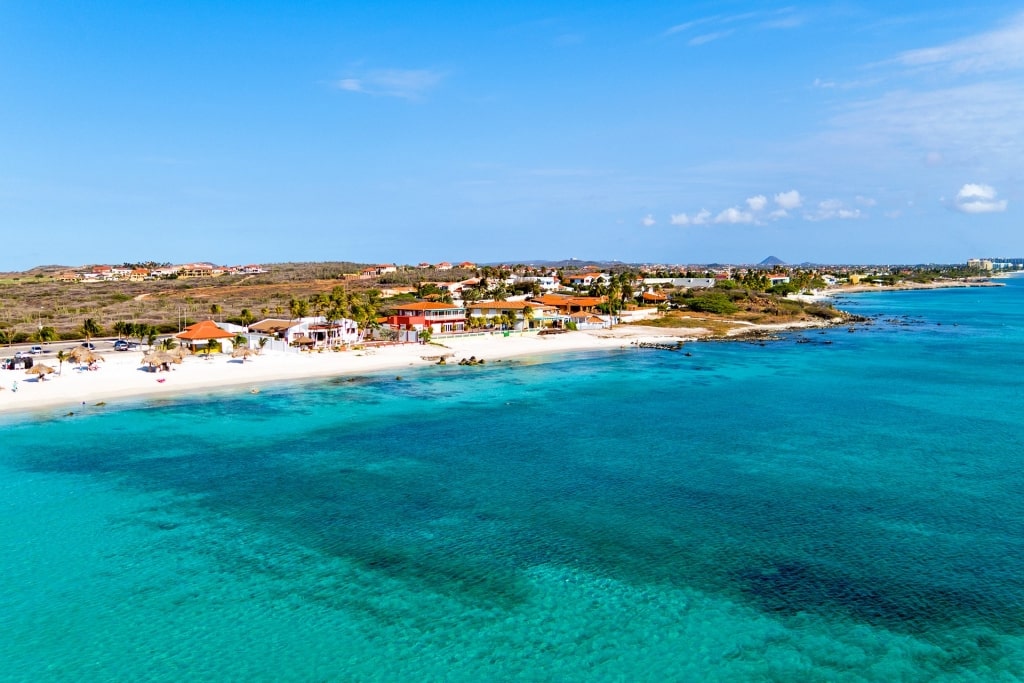
Boca Catalina
If you can only go on one snorkeling trip while on the island, head to Boca Catalina, which has everything a snorkeler could ever want and is considered the best site for snorkeling in Aruba.
Located near a white sand beach, Boca Catalina can be reached by swimming off the shore. If you’re only a casual snorkeler, Boca Catalina’s optimal location allows you to hop in and out of the water—there’s no need to spend hours out in the ocean.
However, if you’re not interested in spending some time on the sand, you can also go to Boca Catalina by boat. The water is calm and warm, making entry to and from the boat a breeze. Most boats will take you to Catalina Cove, which is a little rocky when entering off the shore.
Since so many snorkel boats visit the area, the fish are used to humans and may come up to you in the water. If you have a camera while snorkeling in Aruba, be sure to bring it along as you’ll likely get close to various marine species.
Eagle Beach
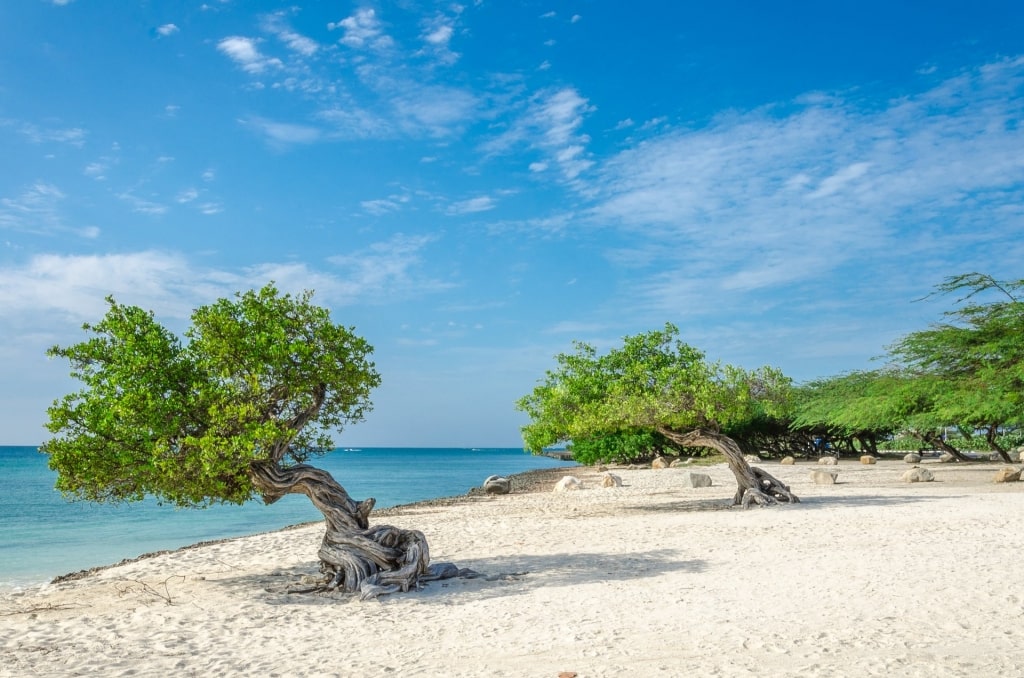
Eagle Beach
Eagle Beach is one of the best beaches in Aruba. Not only is it close to Oranjestad, but it’s also a sea turtle nesting ground. (If you happen to see them relaxing on the island, make sure to keep your distance.)
As if that wasn’t enough, the beach is also home to two of the most famous fofoti trees that Aruba is known for. The trees look similar to life-sized bonsai and have twisted trunks and branches that reach towards the water. The two fofoti trees on Eagle Beach have been used in numerous Aruba advertising campaigns, and the beach usually has photographers snapping shots at sunset.
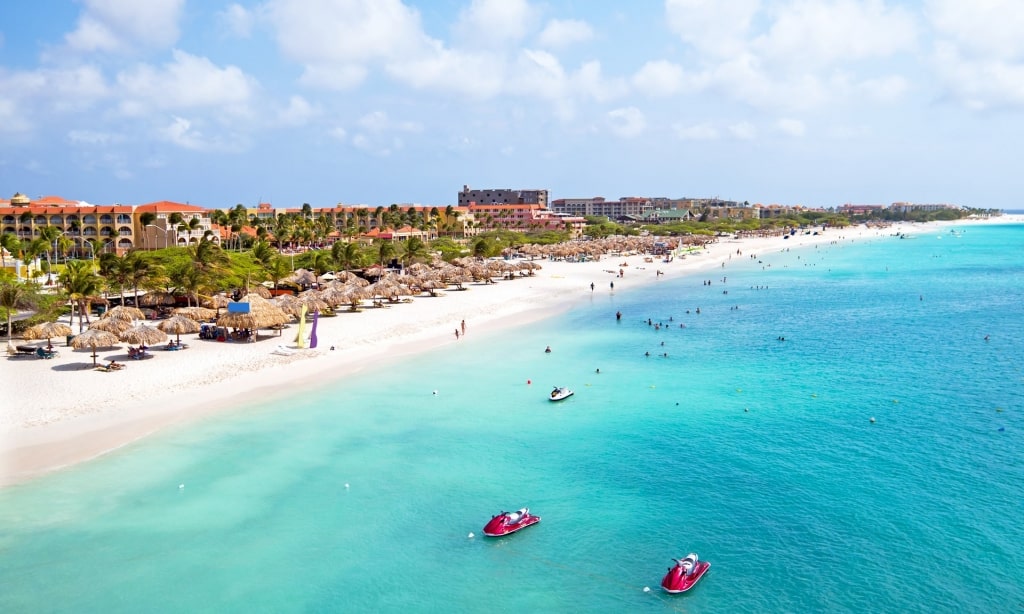
Eagle Beach
If you’re searching for tropical fish, you’re also in luck. While Eagle Beach doesn’t have a reef, it does have the distinction of being one of the easiest places to snorkel on the island. You can find fish and crabs in water no more than a few feet deep. Even better, you don’t have to bring your snorkel gear as there are numerous beach vendors that rent everything you could need if you decide to go snorkeling at the last minute.
Eagle Beach is one of the best places to snorkel in Aruba if you’re short on time, or if you want to be in a spot near shopping and great restaurants, too.
Read: Best Places to Shop in Aruba
Malmok Beach
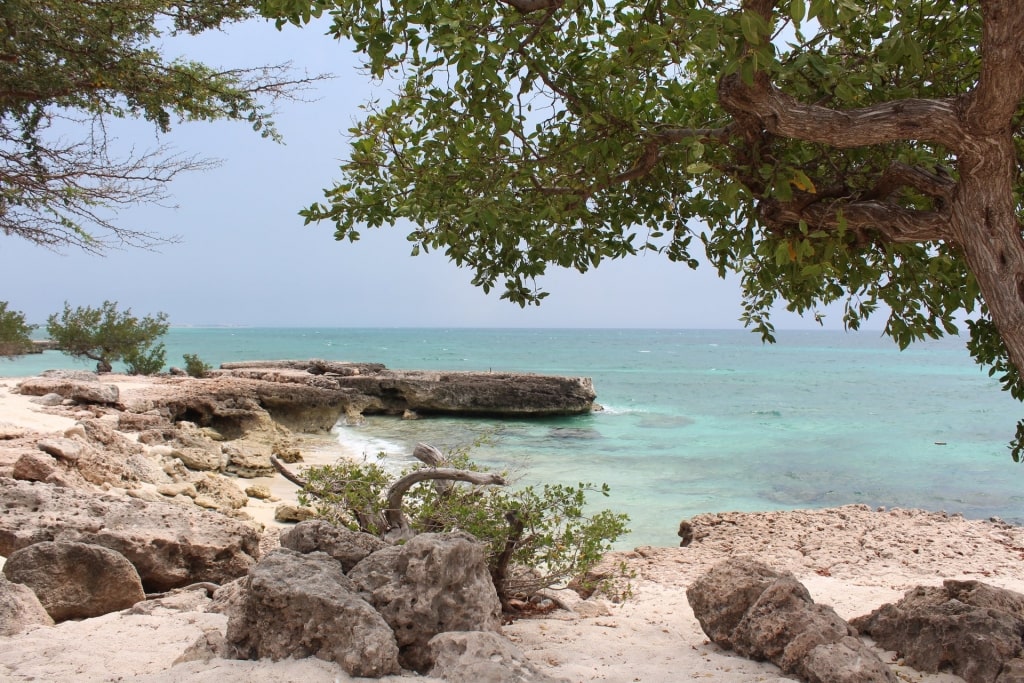
Malmok Beach
Malmok Beach is a popular area for every kind of recreation, and you’ll often see tourists and locals running or cycling on the road that winds along the shore.
Bring your snorkel gear since Malmok Beach doesn’t have any facilities. Also, because of its popularity with snorkelers on the island, the water can get a bit crowded by mid-afternoon. Try to arrive early if you want the fish all to yourself.
At the reef just off the shore, expect to see dozens of different species of fish, as well as bottom-dwelling creatures like crustaceans and eels. You may want to bring water shoes for the small rocks located at the entry and exit of the reef.
If you’re interested in identifying everything you see, buy an Aruba fish ID card in advance and carry it underwater with you.
Tres Trapi Beach
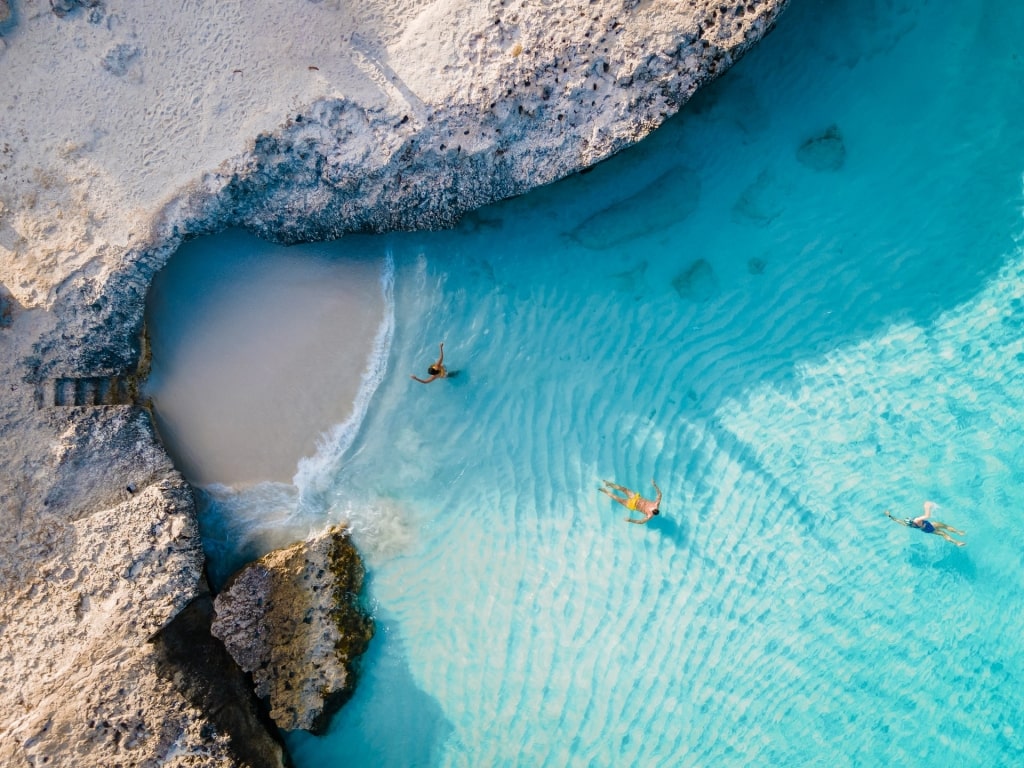
Tres Trapi Beach
Just a few minutes north of Malmok Beach is another one of the best spots for snorkeling in Aruba: Tres Trapi Beach. Tres Trapi (which means “three steps”) has a straightforward entrance into the ocean and while you won’t find a reef, you will find dozens of starfish.
To see the starfish, swim about 20 meters straight out from the ocean entry steps. From there, and for the next 200 or so feet ahead, you’ll start to see starfish dotting the ocean floor. They are usually located in about 10 feet of water, making it easy to see them while snorkeling. Color-wise, they can range from deep brown hues to extremely vibrant shades of red, orange, and yellow.

Tres Trapi Beach
There are several different species of starfish (also known as sea stars) in Aruba, but the most common one on the island is the cushion sea star, which is mostly what you’ll find at Tres Trapi. They look a bit stumpy or squatty with meaty centers and thick, short legs. As with all living creatures under the water, it’s best not to handle them. However, they won’t hurt you if you accidentally touch one of them.
Mangel Halto
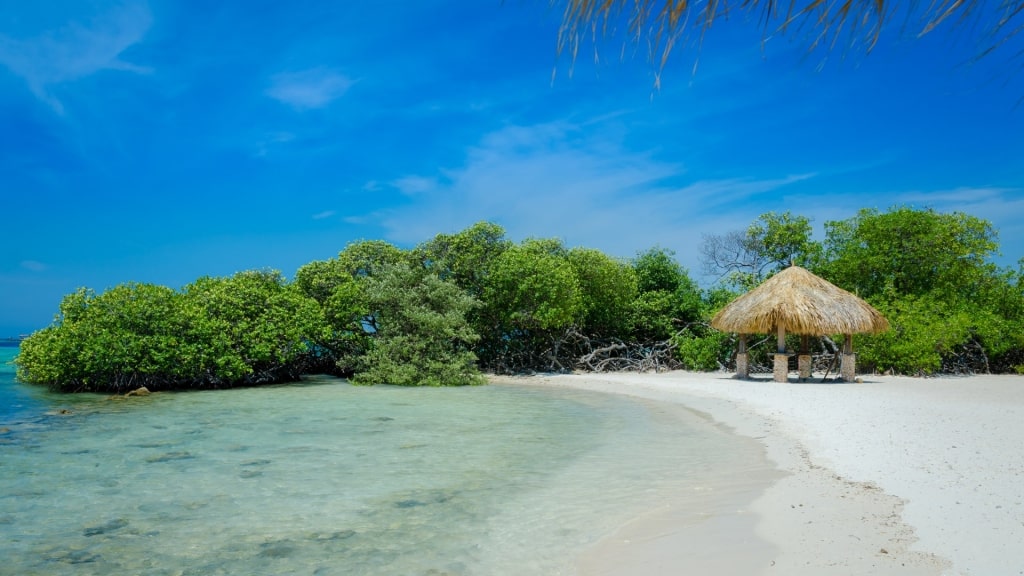
Mangel Halto
About 20 minutes south of Oranjestad, Mangel Halto sits behind a mangrove thicket that creates a beach that feels private and secluded. There’s a small sunken tugboat by the nearest buoy and the sea has that perfect shade of Caribbean turquoise blue, as well as the ideal Caribbean temperature, sitting steadily around 78-85 degrees F. It’s one of the most popular spots for snorkeling in Aruba, especially since there’s a nearby reef.
You can enter the water via the large platform dock or by walking in between the mangroves—bring water shoes as rocks and shells can wash up around the roots.
The currents beyond the reef can be strong, so beginners will want to stay near the shallow bay area, where the water closest to land is relatively calm. Strong swimmers can exit the sheltered bay via one of the gaps in the reef and explore the other side. But make sure to take a second to pause while inside the reef and evaluate the current and swells before swimming in further.
Angelfish, parrotfish, and big-eyed pufferfish are very common. Be careful where you step as there’s also a lot of coral in this area.
Baby Beach
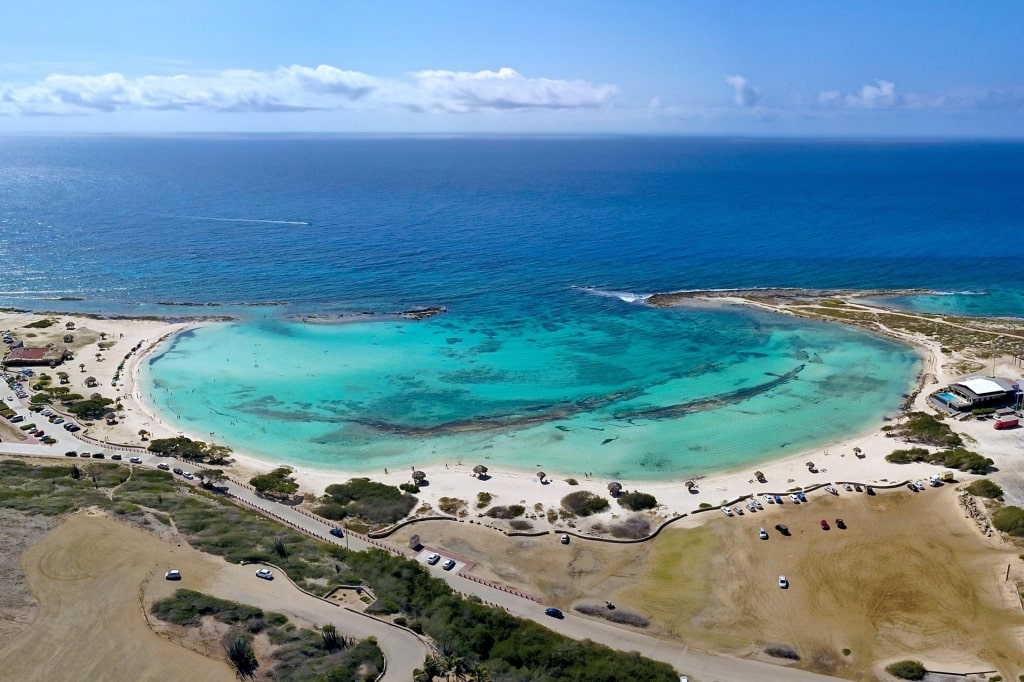
Baby Beach
Don’t let Baby Beach’s adorable name fool you; it’s one of the largest and best beaches for snorkeling in Aruba. Unlike other sites on this list, Baby Beach is a half-moon-shaped bay that opens to the ocean on two sides with a large sandbar in the middle to block currents, waves, and swells.
The protected water off Baby Beach is where you’ll find some of the best snorkeling in Aruba. The bay is massive and has a gradual drop-off, which allows you to walk 50 or 60 yards out and still touch the bottom. You can bring your snorkel equipment or swing by one of the local beach shops that rent everything from snorkel gear to sun loungers and umbrellas. (Don’t forget to order a beachside cocktail, too.)
As there are strong currents outside of the cove, most of the marine life stays close to shore, meaning you’ll have a good chance at seeing parrotfish, small squid, crabs, and even eels and barracudas.
Arashi Reef
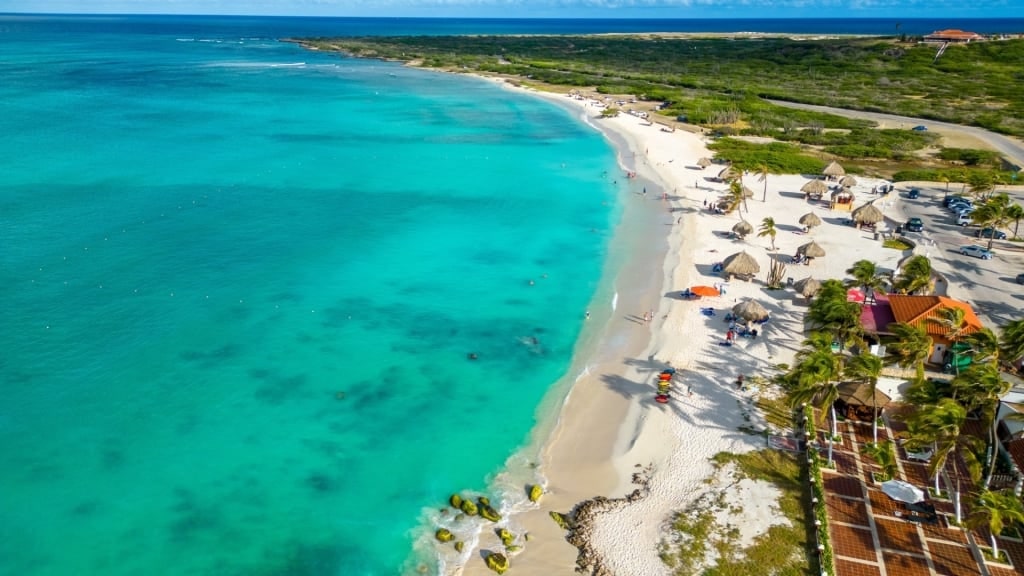
Arashi Beach
Not far from the California Lighthouse on the northern tip of the island, this vibrant reef sits just off Blue Flag Arashi Beach and is a prime spot for snorkeling in Aruba. Its thriving marine life and clear waters make it a favorite of both divers and stronger snorkelers looking for a great experience that can be accessed not too far offshore.
While you can swim out to the reef, that’s recommended for strong swimmers only, and access via boat is a much better way to arrive. Once there, there’s much to see with elkhorn and brain corals providing a colorful backdrop for angelfish, parrotfish, moray eels, lobsters, and, occasionally, sea turtles.
Look out too for the remains of a sunken Lockheed Lodestar aircraft here. It’s hard to spot with surface snorkeling but you may see a glint of metal catching the sun’s rays. Back on land, the beach is pretty quiet with a relaxing atmosphere, as well as being supremely well organized with palapas for shade, lounge chair rentals, and a snack bar.
Rodger’s Beach
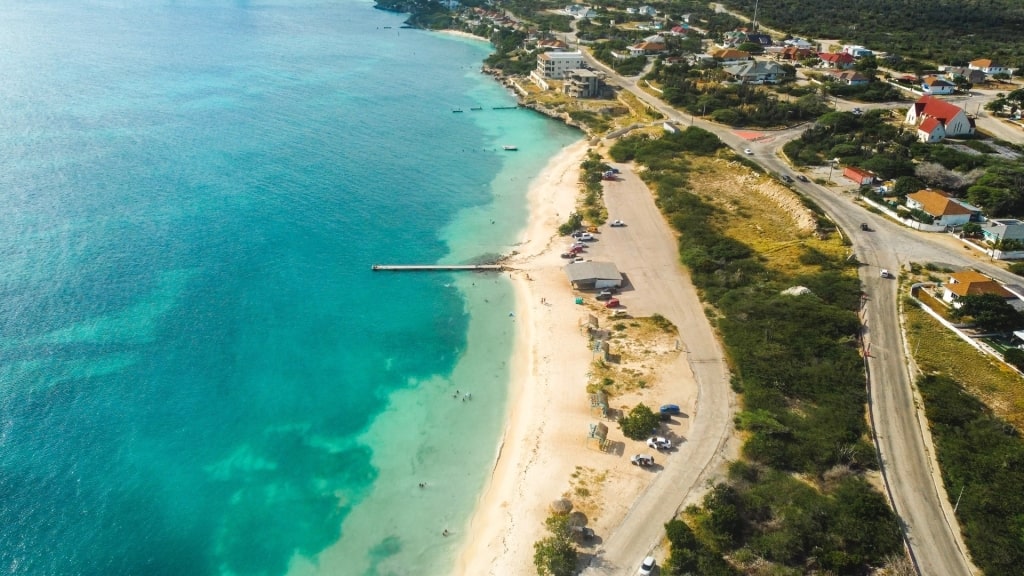
Rodger’s Beach
Named after a British man who set up an oil refinery just down the coast, Rodger’s Beach is often overshadowed by its more upscale neighbor, Baby Beach.
With the refinery in the distance adding to the off-radar feel of a day out here, it means that crowds are usually low, but the snorkeling is surprisingly good for those who know where to look. As such, this is a great spot for those who are taking their first forays into snorkeling in Aruba.
While the sea life may not be as varied as on some of the more famed reefs, there’s still plenty to see, especially along the rocky breakwaters and near the small jetty. Expect a mix of small tropical fish like sergeant majors, damselfish, and blue tangs, in waters that tend to be calm and shallow, with a gentle slope off the beach. Social-media worthy snaps can also be had here thanks to the contrast of the old refinery backdrop, typically white Caribbean sands, and turquoise waters.
Spanish Lagoon
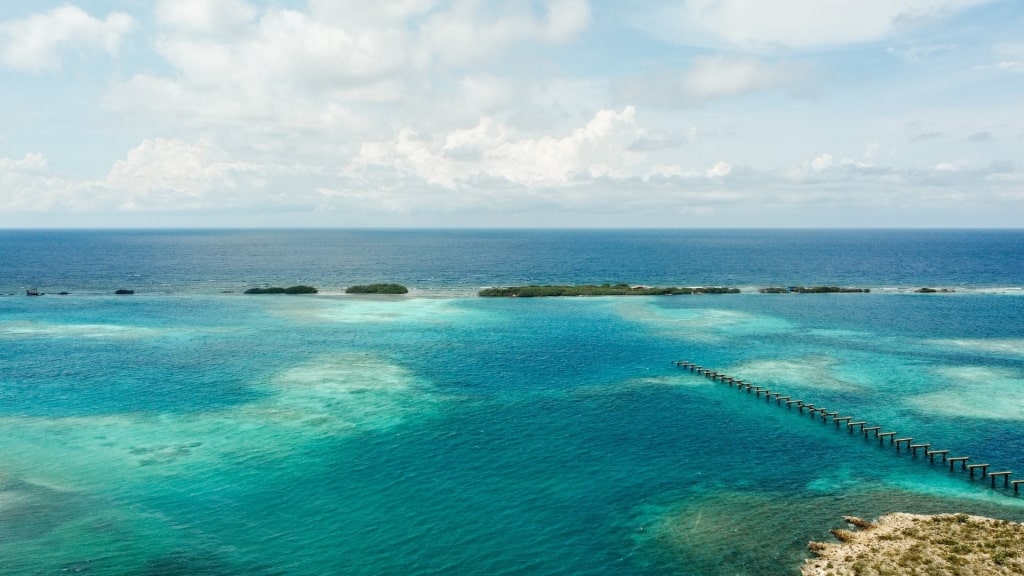
Spanish Lagoon
Spanish Lagoon is probably Aruba’s most historic snorkeling spot, given that it takes its name from being the main entry point to the island for Spanish colonialists back in the 15th century.
Today it’s one of the largest inland lagoons in the Caribbean, covering more than 170 acres. Its mangrove-lined shores make it one of the most biodiverse locations on the island, too, wearing the conservation mantle of being part of the Ramsar network, which lists wetlands of international importance, since 1980.
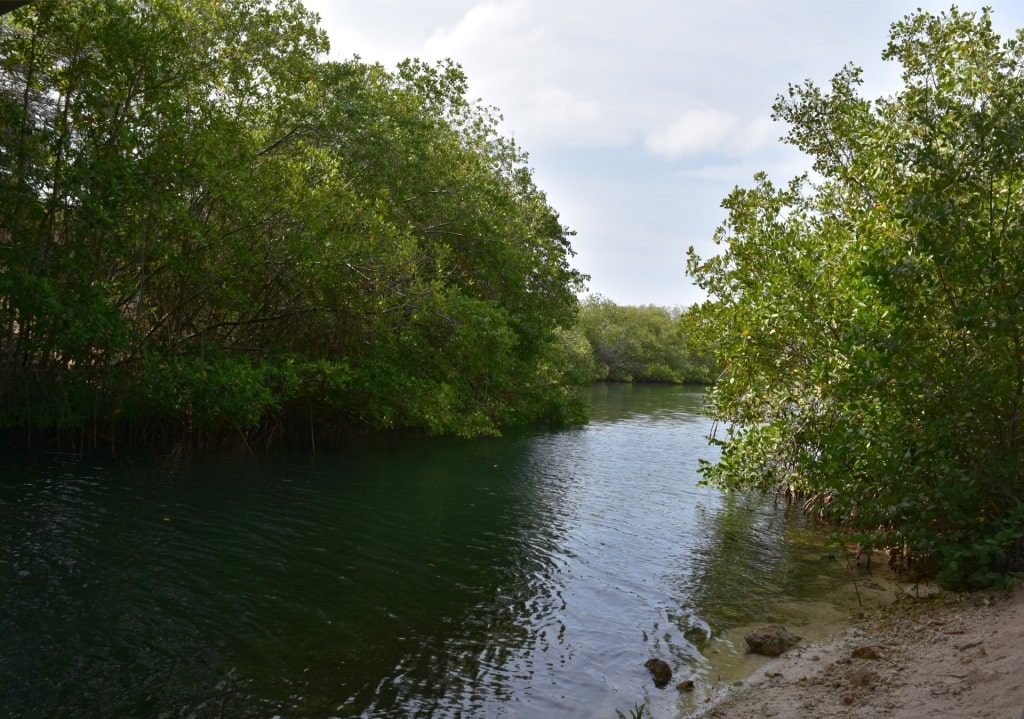
Spanish Lagoon
Those mangroves make it a veritable nursery for fish with parrotfish, wrasse, yellowtail, tang, and butterflyfish all in abundance, both around the roots of these sea plants and the lagoon’s coral formations. With relatively shallow areas and deeper spots at the reefs, it can cater for all tastes–-with access usually via some kind of guided tour, often on kayaks to get to the best spots.
Given the lagoon’s protected status, there are limited amenities here so it is recommended that visitors bring all the necessary gear and provisions.
Isla di Oro Lagoon
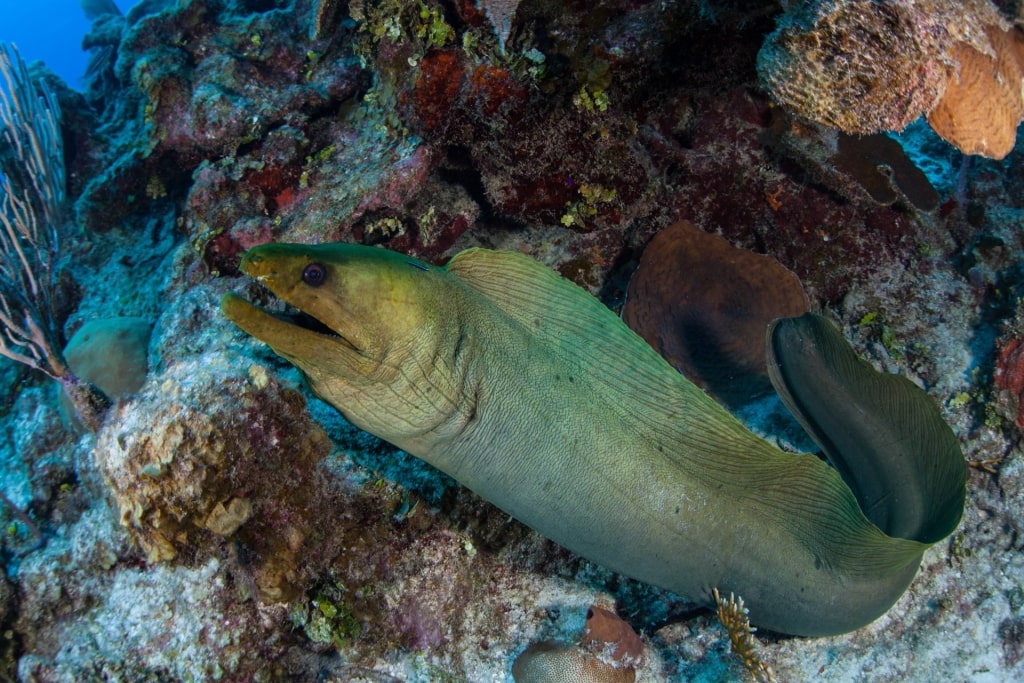
Green moray eel
Isla di Oro is another great lagoon for snorkeling in Aruba. Tucked away near Pos Chiquito on the south-west coast, it’s formed by a hook-like promontory that juts into the sea to create a large mangrove wetland. Those mangroves combine with some excellent coral formations—brain, staghorn, star, and plate—to create a perfect setting for both those with a snorkel and those looking for a deeper dive with tanks.
The vibrant reef means that French, gray, and queen angelfish, as well as porcupine fish can be seen hiding in the crevasses. Meanwhile, brightly colored trumpet fish dart in and out among the coral, while green moray eels and lobsters may also be seen if you have sharp eyes.
The calm waters here mean you can snorkel right off the beach, though some of the best spots may require a bit of a wade through the mangroves.
Isla di Oro was once a popular party spot in the 1970s and 80s and is still home to an abandoned restaurant in the shape of a boat. But there are few facilities here so pack all you need to take before setting out.
Santo Largo/ Savaneta Beach
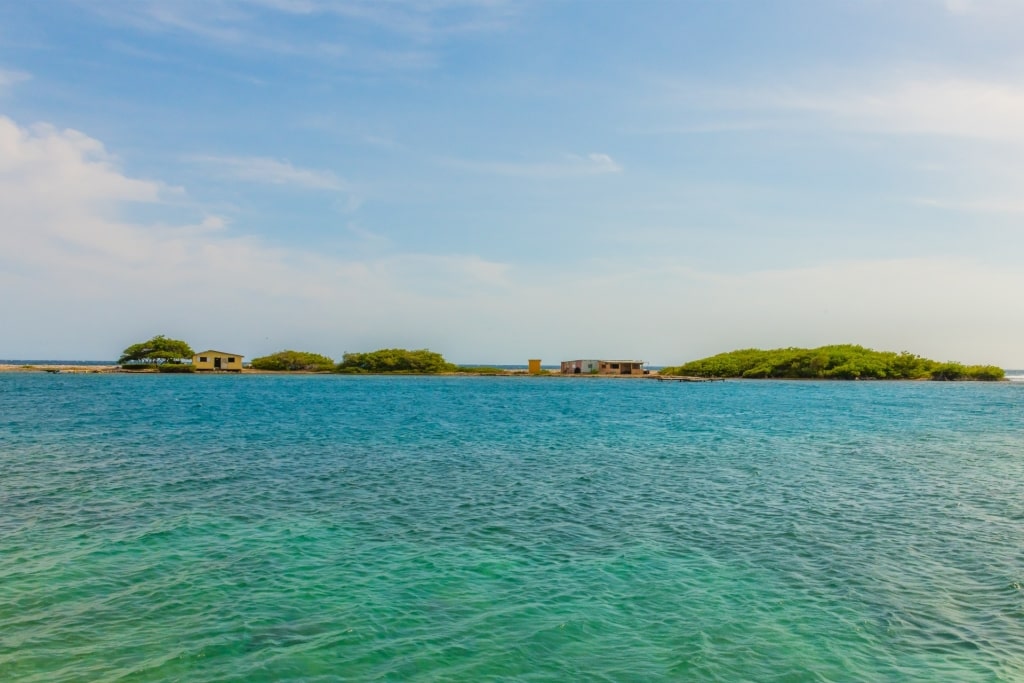
Savaneta
Another great beginner location for snorkeling in Aruba is Santo Largo, also known as Savaneta Beach. Just south of the prime Mangel Halto spot on the south-west coast, the beach is known for its soft white sand and gently sloping sea floor, as well as its low crowds.
While Santo Largo lacks the “wow” factor of some of the more thriving reefs, you can enter the water right off the sand here. Once in, you’ll find some shallow coral beds with small reef fish like sergeant majors and wrasse, the odd sea cucumber, and sea grass gently moving with the waves.
As such, it’s a great spot to simply float and drift without too much effort. Post snorkeling, there are no beach facilities, but it’s a great spot to take a picnic and get away from the crowds on the island’s busier beaches.
Puerto Chiquito
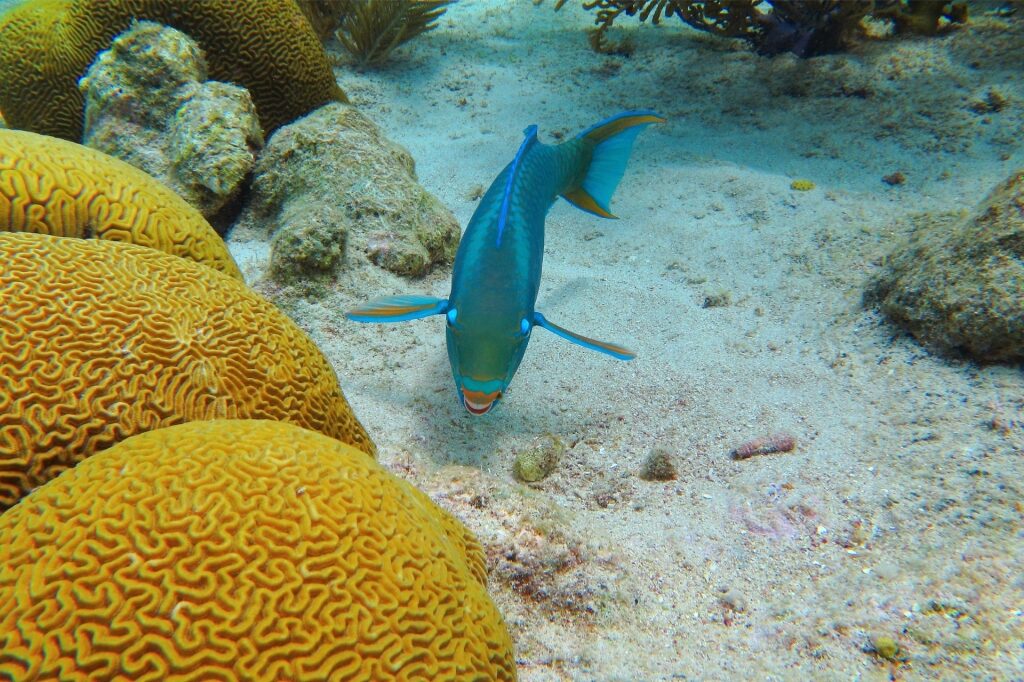
Parrotfish
For more advanced snorkelers looking for something different, Puerto Chiquito is another great location for snorkeling in Aruba, close to Mangel Halto. There’s no sandy beach here, rather some rock jetty walls from which to enter the water.
As a lesser-known spot, the experience is more secluded, but the reef is vibrant, including a mix of hard and soft corals, including brain, star, and pillar. Float around for a while to see angelfish, parrotfish, trumpetfish, and occasionally sea turtles and rays. The site is fairly exposed, so you have to pay attention to weather conditions and to have good swimming skills unless the water is absolutely still.
For the more adventurous, you can enter here and drift south along the reef to Mangel Halto, returning on foot to the entry site if needed.
As with many places in Aruba, Puerto Chiquito has several names, the most common alternative being Hole in the Wall, also the name of the popular scuba diving site here.
Colorado Point
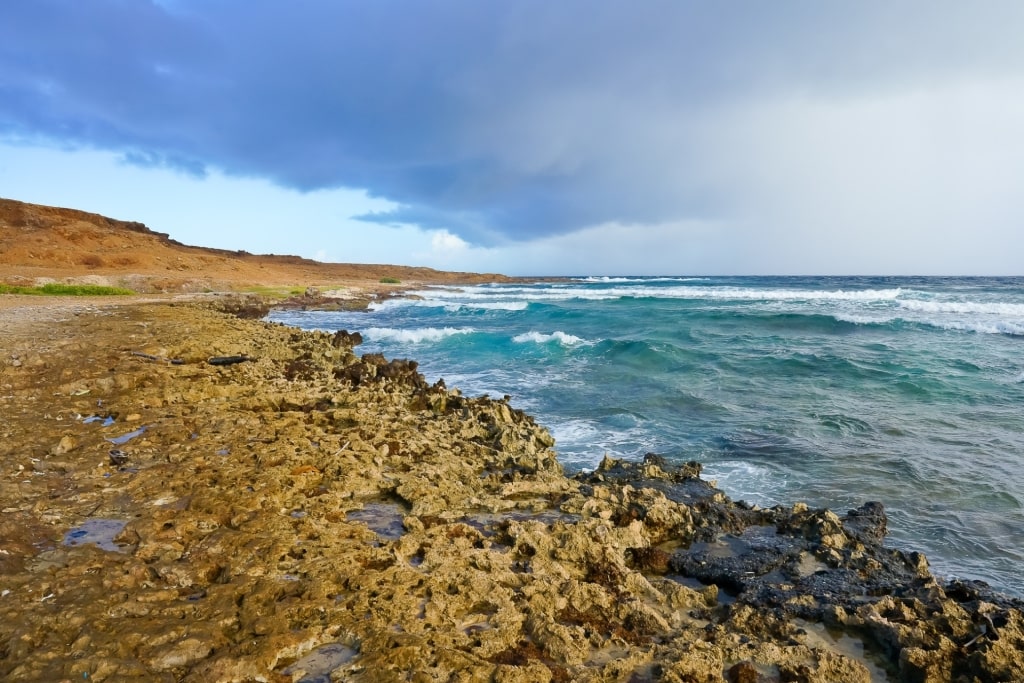
Colorado Point
If you head down to Baby Beach for your snorkeling adventure and the beach is too busy, Colorado Point, just up the road, is a decent alternative. Also known as Punta Basora, the remote and rugged headland has a small beach area where a reef offers a lagoon-like feel close to shore.
The water here doesn’t get deeper than 10 feet so there is much to see around the coral bommies and rocks for those with a snorkel. Venture out for blue tangs, yellowtail snappers, parrotfish, yellow goatfish, and damselfish.
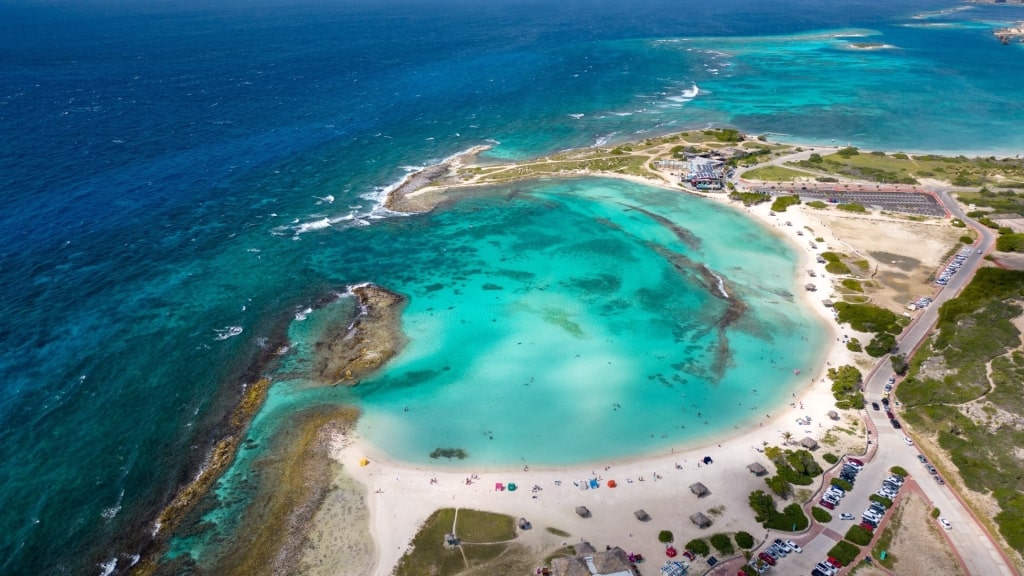
Baby Beach
To find the beach, follow the road east past the parking lot at Baby Beach and look for a sign on the wall. If you pass the Pet Cemetery, you’ve gone too far. This is another remote beach so you may only see a couple of people around. When packing for your day out, bear in mind there are no facilities here, so take appropriate provisions.
The Pedernales Wreck
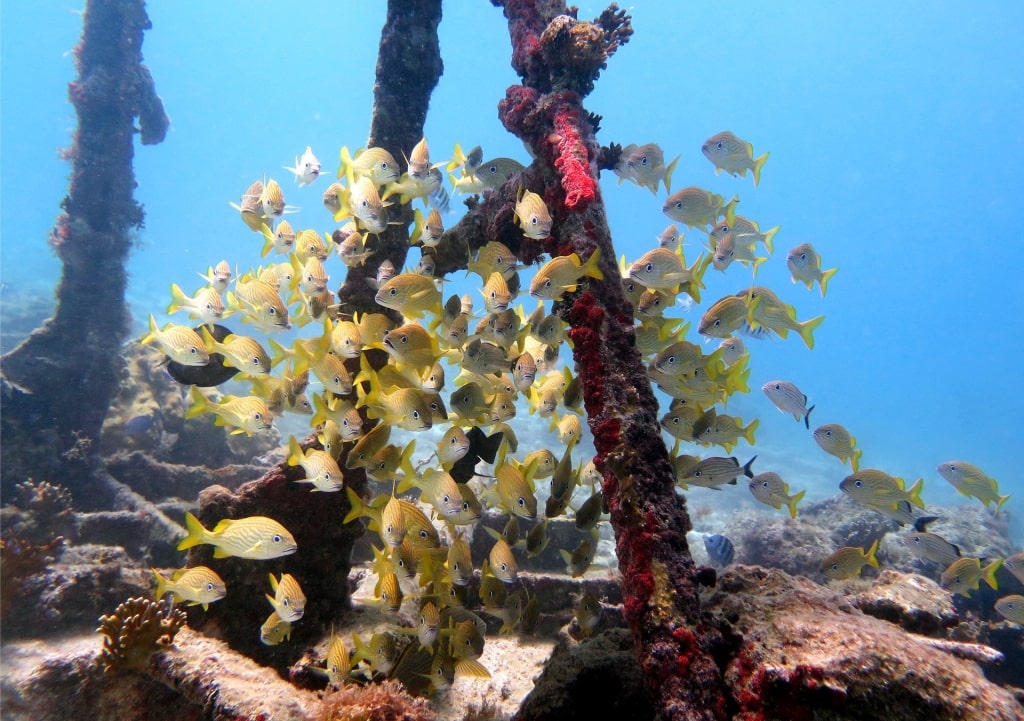
The Pedernales Wreck
The Pedernales Wreck is a popular dive site in Aruba that those without scuba gear can access with snorkeling equipment. While the best sightings are at depth, it’s a great place for snorkelers taking their next steps.
The Pedernales was a Second World War oil tanker torpedoed by a German U-boat in 1942 and later scuttled after being used for target practice by the Dutch navy. Over the years since it sank, the wreck has split into sections to form a series of artificial reefs with modest but increasingly growing coral.
Divers will be able to spot larger fish and the occasional octopus at depth, while surface snorkelers and free divers will likely happen across angelfish, grouper, damselfish, sergeant majors, and trumpetfish. The best way to get to the site is on a snorkel/diving combined tour.
Read: Best Scuba Diving in the Caribbean
FAQs
What is the best time of year to snorkel in Aruba?
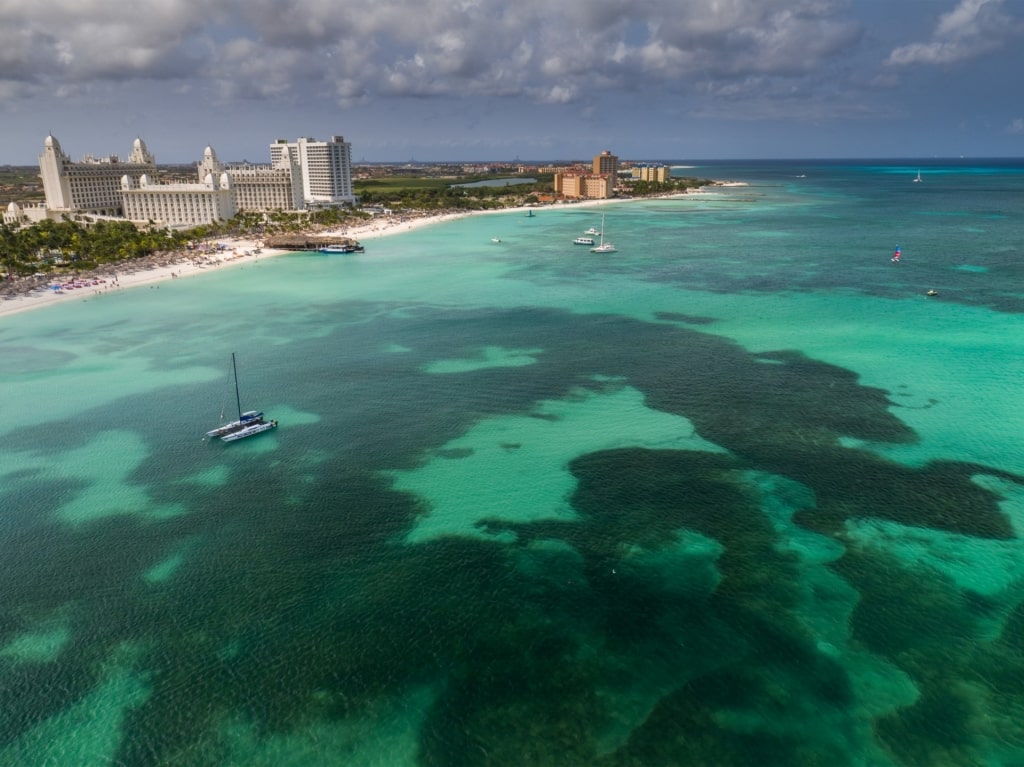
Aruba
Thanks to fairly calm and warm waters, limited rainfall, and it not being a hurricane hotspot, you can pretty much snorkel year-round in Aruba. There’s slightly more rain and higher humidity from September to late December, while the turn of the year sees cooler breezes and more rain action, but there’s still snorkeling to be had.
Prime time, though, is April through August: calmer seas, slightly warmer weather, and the occasional light wind for drifting.
If you want fewer crowds on your Aruba snorkeling adventure, make sure to visit before the end of June before peak season starts in July.
Where is the best place to snorkel with turtles in Aruba?
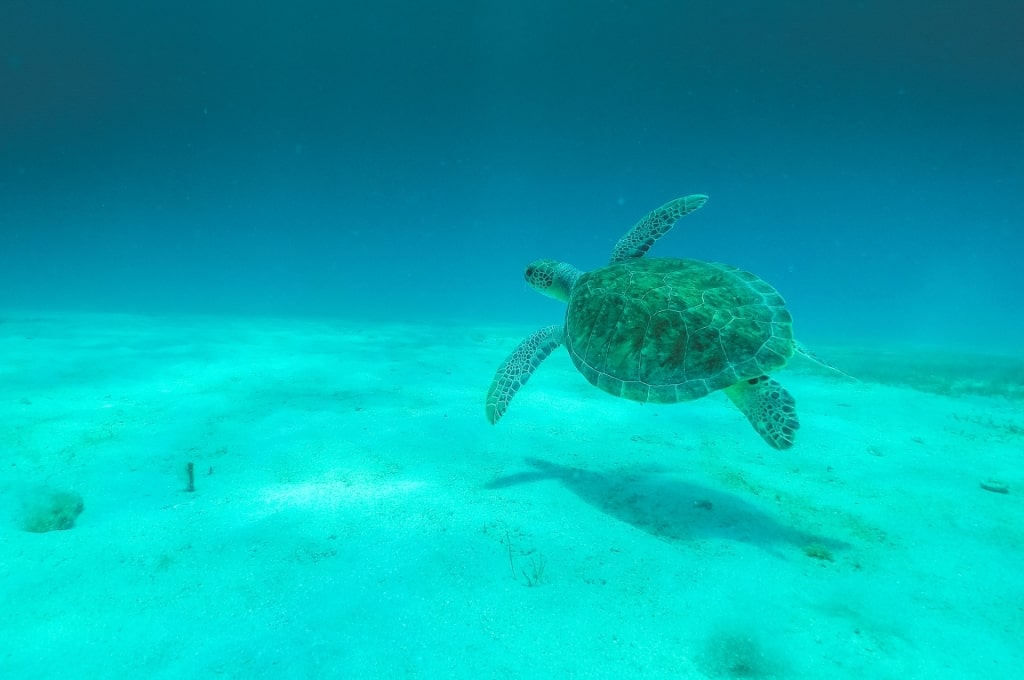
Sea turtle
Turtles tend to love seagrass beds—it’s where they feed, so looking for spots with larger fields offers the best chance of seeing these graceful creatures when snorkeling in Aruba.
Boca Cataline, with its calm, shallow waters is a great place to check out green sea turtles. Tres Trapi, near the Antilla shipwreck also provides great conditions for turtle spotting, thanks to the gentle currents there. Other well-known turtle hotspots include Arashi Reef and Puerto Chiquito.
Should I bring my own snorkel gear to Aruba?
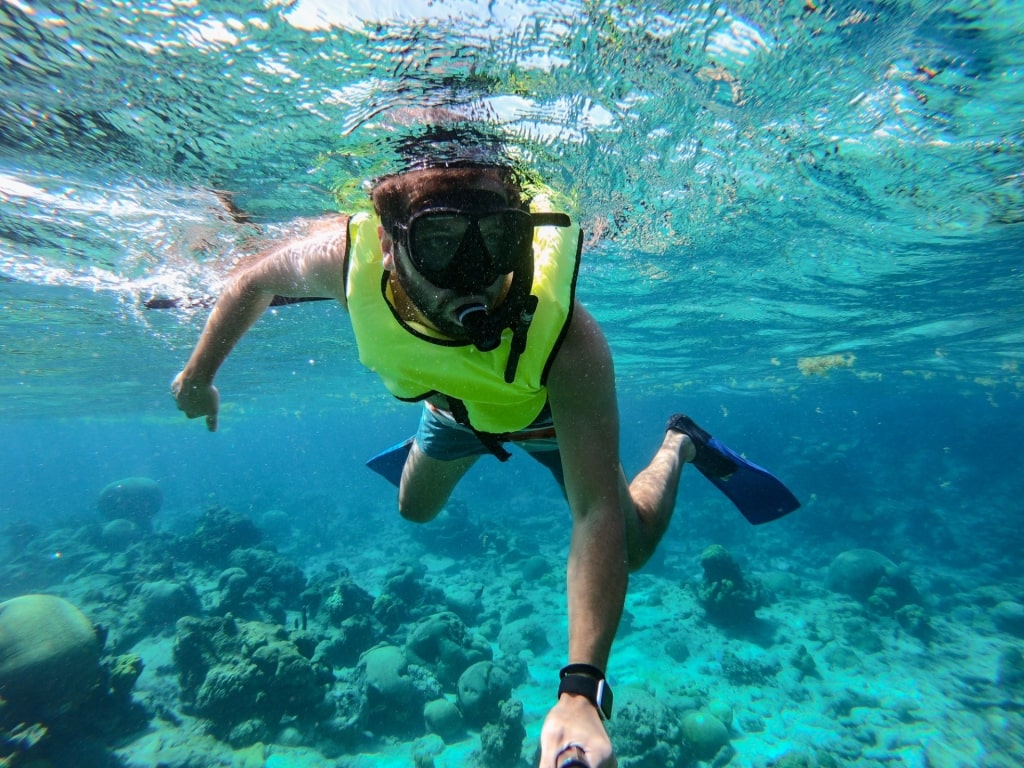
Snorkeling
It all depends on how particular you are. If you care about fit, flexibility, or fish-spotting finesse, or if you use a prescription mask, then yes. But the vast majority of guided snorkel trips in Aruba will include gear in the price, and there are several places around the island where you can rent masks, snorkels, and fins.
Beware, though, as this may not be top-class gear. If you’re the kind of person who may only do one or two snorkeling expeditions, these will likely do. You could compromise by bringing your own mask and snorkel but using fins, which are bulky to pack, provided by your excursion operator.
What kind of fish can I see when snorkeling in Aruba?
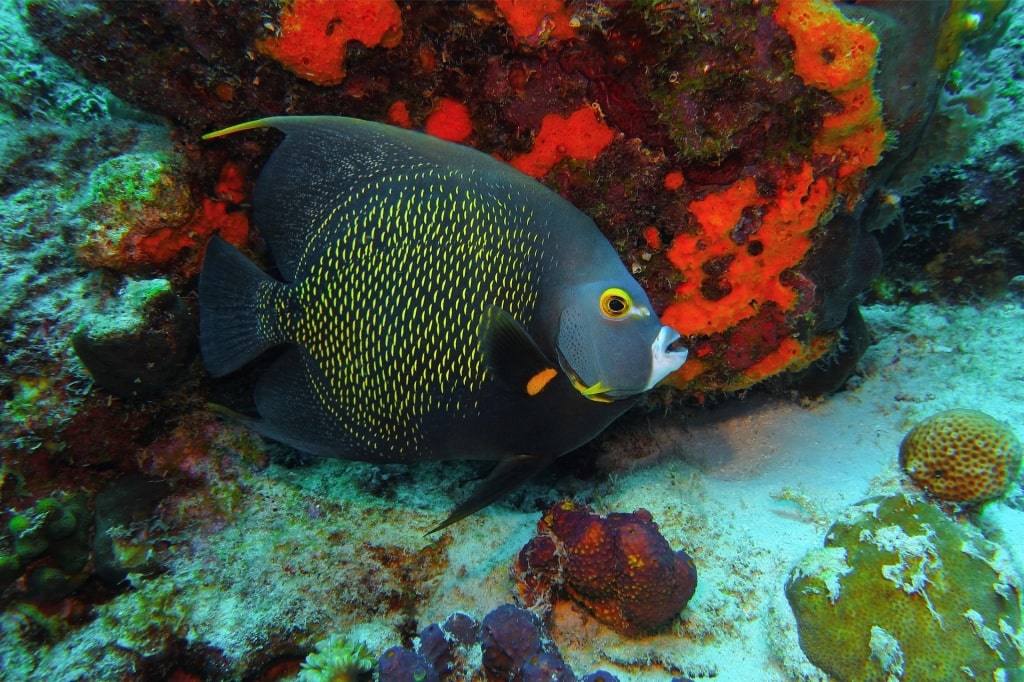
Angelfish
The fish cast for snorkeling in Aruba reads a little like a greatest hits of things you’re likely to see in the Caribbean, as bold colors and varying shapes abound.
While you’re likely to spot plenty of life just floating on the surface, the deeper you go—or sometimes the further out to sea you are—the larger the fish on offer. Around the reefs, you’re likely to see parrotfish darting about with their greens, blues, and purples flashing away, as well as blue tang, bossy sergeant majors, and graceful angelfish. Then there are the long, thin, and slightly strange looking trumpetfish, and small, dainty butterfly fish.
Moray eels may look menacing as they poke their heads from holes, but they tend to be relatively relaxed unless cornered. They also make for great underwater snaps if you have an appropriate camera.
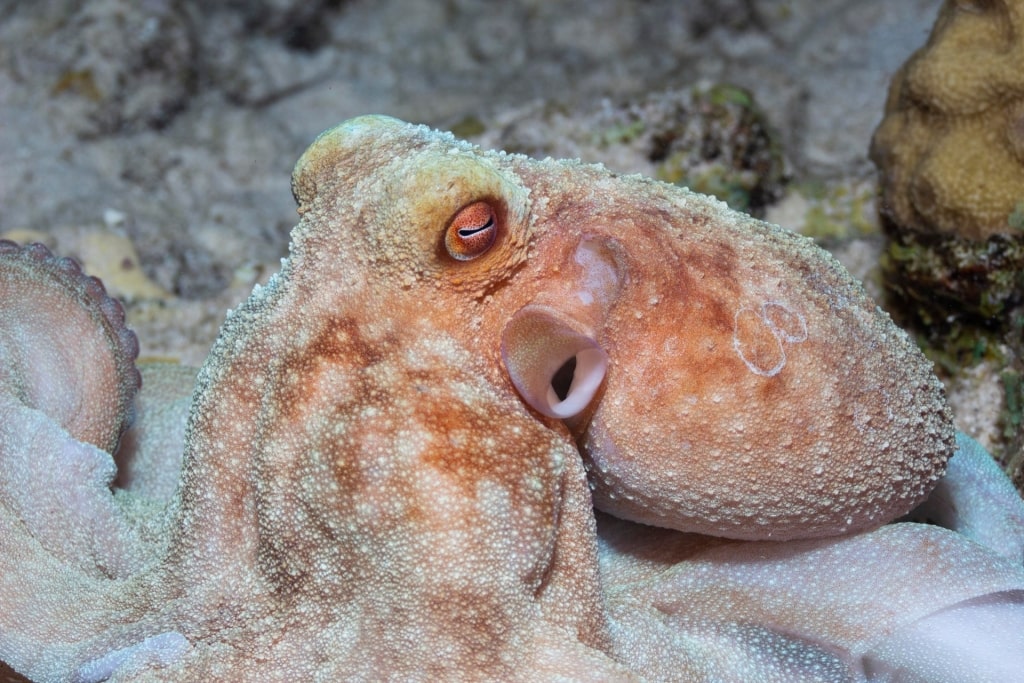
Octopus
Spotted eagle rays are quite rare but also quite magical if you happen across one. Among all the fish, let’s not forget octopus, sea turtles, and lobsters, as well as the ultimate chilled out ocean dweller, sea cucumbers.
Where can I snorkel from the beach in Aruba?
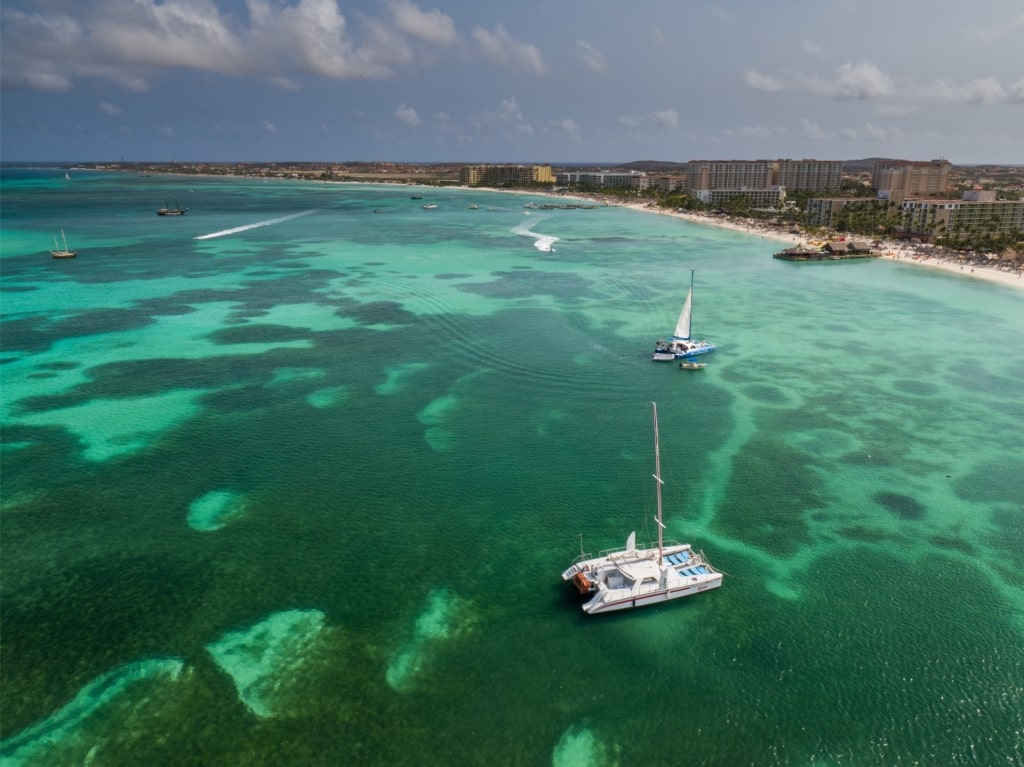
Aruba
The short answer is, almost everywhere. Yes, it’s true, boat trips to the edge of coral reefs or offshore wrecks probably offer the best all-round experience for snorkeling in Aruba. As above, the rule of thumb is usually the further from shore and the deeper the reef, the more there is to see. But for anyone looking for a quick experience or those less confident in the water, there are dozens of places to don snorkel, mask, and fins and walk straight off the sand into the ocean.
The best places are probably those that have a lagoon element as mangroves provide a perfect protective environment for many fish, especially when they are new-born or just a few months old. The downside is that you may have to wade through those very same mangroves to get to the water, which adds an extra challenge.
Once in the water at spots like Isla di Oro and Spanish Lagoon, the snorkeling world is your oyster. In other locations such as De Palm Island, the reef is just offshore meaning you get great snorkeling in just a few feet of water.
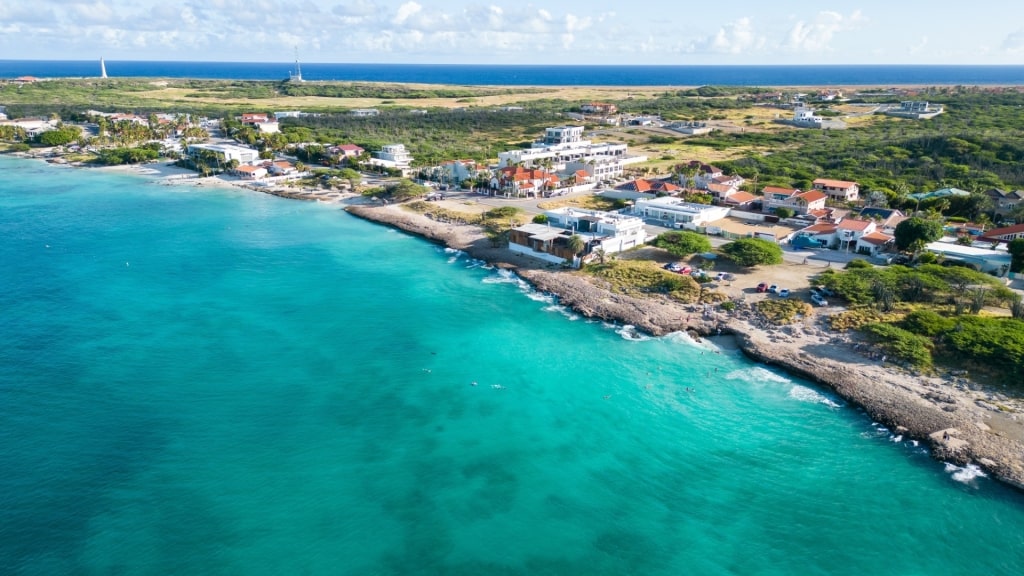
Tres Trapi
Elsewhere, convenience can be your friend. At Tres Trapi, for instance, there is no reef but lots to see as soon as you dip your head under the surface.
Read: Best Snorkeling in the Caribbean
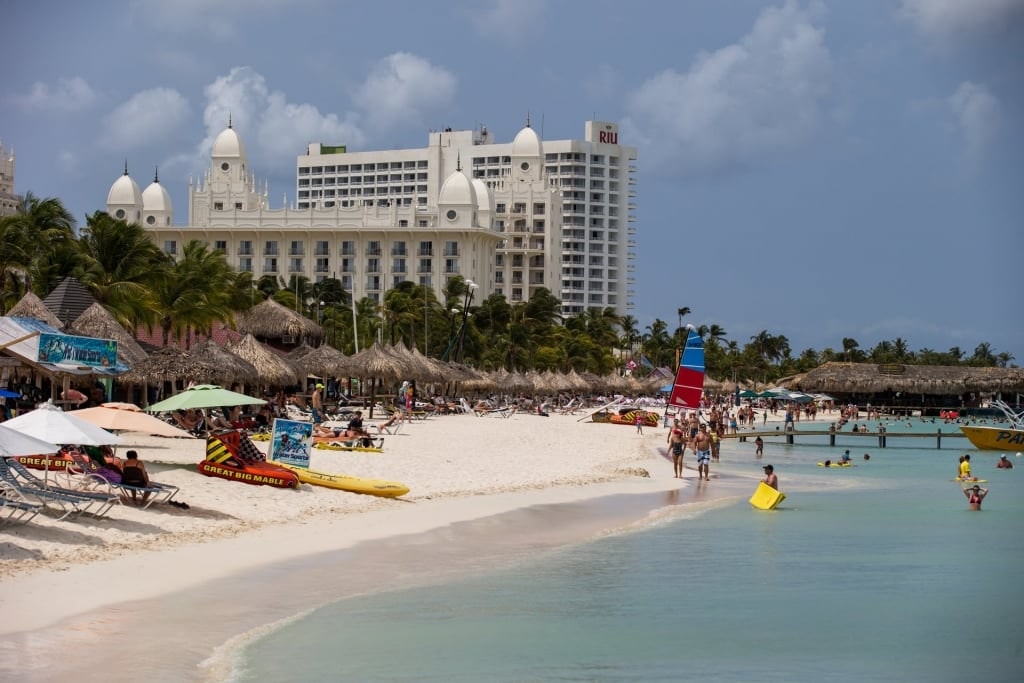
Aruba
Of course, there’s far more to do in Aruba than snorkeling. On this tropical island, you can go on a guided horseback ride, hop on a sunset cocktail cruise, or even cruise 100 feet below the surface in a submarine. If you’re ready to book your next tropical getaway, browse cruises to Aruba on our website and explore all of the exciting excursions available.
